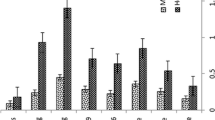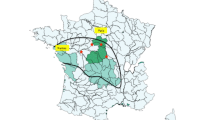Abstract
The concentrations of polychlorinated biphenyl (PCBs) congeners including highly toxic non-, mono-, and di-ortho coplanar members as well as their pattern were determined in breast muscles of white-tailed sea eagles collected dead between 1982 and 1990 in Poland. There was a wide variation in total PCB residue concentrations among eagles from various breeding sites, with the Baltic Sea coast registering the highest concentrations. The pattern of PCB residues differed between the eagles examined. Hexa-, hepta-, and pentachlorobiphenyls contributed between 45 and 56%, 18-and 37%, and 9 and 22% in total PCBs, respectively. Toxic equivalents (TEQs) of 2,3,7,8-tetrachlorodibenzo-p-dioxin (TCDD) for non-, mono-, and di-ortho coplanar PCBs were very high (8.0–72 μg/g wet wt) in white-tailed sea eagles from breeding sites of the coastal area of the southwestern Baltic Sea, and were relatively lower (0.69–4.0 μg/g wet wt) in other birds, including two specimens from breeding sites of inland Poland, which died because of acute lead poisoning. PCB IUPAC Nos. 118, 105, 126, and 156 were the highest contributors to the TCDD TEQ of coplanar members, occupying between 39.1 and 57.0%, 9.8 and 17.5%, 7.4 and 22.3%, and 7.0 and 14.2%, respectively. The concentrations of coplanar PCBs in adult white-tailed sea eagles were the highest ever reported in wildlife, but that of total PCBs were similar to those reported in dead eagles from the breeding sites of the coastal area of the northern Baltic in Sweden and Finland in the 1960s and 1970s.
Similar content being viewed by others
References
Berg W, Johnels A, Sjöstrand B, Westermark T (1966) Mercury content in feathers of Swedish birds from the past 100 years. Oikos 17:71–83
Borg K, Wanntrop H, Erne K, Hanko E (1969) Alkyl mercury poisoning in terrestrial Swedish wildlife. Viltrevy 6:301–358
Falandysz J (1984) Metals and organochlorines in a female white-tailed eagle from Uznam Island, southwestern Baltic sea. Environ Conserv 11:262–263
— (1986) Metals and organochlorines in adult and immature males of white-tailed eagle. Environ Conserv 13:69–70
-- (1993) An evidence for a steady state of PCBs in the Baltic proper vs. concentrations observed in the open north and northeastern region of the Atlantic Ocean (to be submitted)
Falandysz J, Jakuczun B, Mizera T (1968) Metals and organochlorines in four female white-tailed eagles. Mar Pollut Bull 19:521–526
Falandysz J, Szefer P (1983) Metals and organochlorines in a specimen of white-tailed eagle. Environ Conserv 10:256–258
Falandysz J, Szefer P (1984) Chlorinated hydrocarbons in fish-eating birds wintering in the Gdańsk Bay, 1981–82 and 1982–83. Mar Pollut Bull 15:298–301
Falandysz J, Yamashita N, Tanabe S, Tatsukawa R, Mizera T, Jakuczun B (1992) Highly toxic non-ortho chlorine coplanar PCB members in white-tailed sea eagles from the coast and inland Poland. IV World Conf Birds of Prey, Berlin, 10–17 May 1992, Abstracts 39
Helander B (1985) Reproduction of the white-tailed sea eagle Haliaeetus albicilla in Sweden. Holoarctic Ecol 8:211–227
Helander B, Olsson M, Reutergardh L (1982) Residue levels of organochlorine and mercury compounds in unhatched eggs and the relationships to breeding success in white-tailed sea eagles Haliaeetus albicilla in Sweden. Holoarctic Ecol 5:349–366
Jensen S, Johnels AG, Olsson M, Otterlind G (1969) DDT and PCB in marine animals from Swedish waters. Nature 224:247–250
Jensen S, Johnels AG, Olsson M, Westermark T (1992) The avifauna of Sweden as indicators of environmental contamination with mercury and organochlorinated hydrocarbons. In EJ Brill (ed) Proc. XVth Int Ornith Cong, Leiden, 1972, pp 455–465
Kannan K, Falandysz J, Yamashita N, Tanabe S, Tatsukawa R (1992) Temporal trends of organochlorine concentrations in cod-liver oil from the southern Baltic proper, 1971–1989. Mar Pollut Bull 24:358–363
Kihlstrom JE, Berglund E (1978) An estimation of the amounts of polychlorinated biphenyls in the biomass of the Baltic. Ambio 7:301–358
Knight GC, Walker CH (1982a) A study of the hepatic microsomal monooxygenase of sea birds and its relationship to organochlorine pollutants. Comp Biochem Physiol 73C:211–221
—, — (1982b) A study of the hepatic microsomal epoxide hydrolase in sea birds. Comp Biochem Physiol 73C:463–467
Koeman JH, Bothof TH, De Vries R, Van Velzen-Blad H, Vos JG (1972) The impact of persistent pollutants in piscivorous and molluscivorous birds. TNO-nieuws 27:561–569
Lincer JL, Peakall DB (1973) PCB pharmacodynamics in the ring dove and early gas chromatographic peak diminution. Environ Pollut 4:59–68
Mizera T, Szymkiewicz M (1991) The trends, status and management of the white-tailed sea eagle Haliaeetus albicilla in Poland. Bull No 4. World Working Group on Birds of Prey (WWGBP), Berlin, Paris, and London, pp 1–10
Pasivirta J, Rantio T (1991) Chloroterpenes and other organochlorines in Baltic, Finnish and Arctic wildlife. Chemosphere 22:47–55
Prestt I, Jefferies DJ, Moore NW (1970) Polychlorinated biphenyls in wild birds in Britain and their avian toxicity. Environ Pollut 1:3–26
Reichel WL, Schmeling SK, Cromartie E, Kaiser TE, Krynitsky AJ, Lamont TG, Mulhern BM, Prouty RM, Stafford CJ, Swineford DM (1984) Pesticide, PCB, and lead residues and necropsy data for bald eagles from 32 states—1978–81. Environ Monit Assess 4:395–403
Safe S (1990) Polychlorinated biphenyls (PCBs) dibenzo-p-dioxins (PCDDs) dibenzofurans (PCDFs), and related compounds: Environmental and mechanistic considerations which support the development of toxic equivalency factors (TEFs). Crit Rev Toxicol 21:51–88
Sileo L, Karstad L, Frank R, Holdrinet MVH, Addison E, Braun HE (1977) Organochlorine poisoning of ringed-billed gulls in southern Ontario. J Wildl Dis 13:313–322
Stickel WH, Stickel LF, Dyrland RA, Hughes DL (1984) Aroclor® 1254 residues in birds: Lethal levels and rates. Arch Environ Contam Toxicol 13:7–13
Tanabe S, Kannan N, Wakimoto T, Tatsukawa R, Okamoto T, Masuda Y (1989) Isomer-specific determination and toxic evaluation of potentially hazardous coplanar PCBs, dibenzofurans and dioxins in the tissues of “Yusho” PCB poisoning victim and in the causal oil. Toxicol Environ Chem 24:215–231
Tarhanen J, Koistinen J, Paasivirta J, Vuorinen PJ, Koivusari J, Nuuja I, Kannan N, Tatsukawa R (1989) Toxic significance of planar aromatic compounds in Baltic ecosystem—new studies on extremely toxic coplanar PCBs. Chemosphere 18:1067–1077
Vos JG, Koeman JH (1970) Comparative toxicologic study with polychlorinated biphenyls in chickens with special reference to porphyria, edema formation, liver necrosis and tissue residues. Toxicol Appl Pharmacol 17:656–668
Wiemeyer SN, Lamont TG, Bunck CM, Sindelar CR, Gramlich FJ, Fraser JD, Byrd MA (1984) Organochlorine pesticide, polychlorobiphenyl and mercury residues in bald eagle eggs—1966–1979—and their relationships to shell thinning and reproduction. Arch Environ Contam Toxicol 13:529–549
Author information
Authors and Affiliations
Rights and permissions
About this article
Cite this article
Falandysz, J., Yamashita, N., Tanabe, S. et al. Congener-specific analysis of polychlorinated biphenyls in white-tailed sea eagles Haliaeetus albicilla collected in Poland. Arch. Environ. Contam. Toxicol. 26, 13–22 (1994). https://doi.org/10.1007/BF00212788
Received:
Revised:
Issue Date:
DOI: https://doi.org/10.1007/BF00212788




